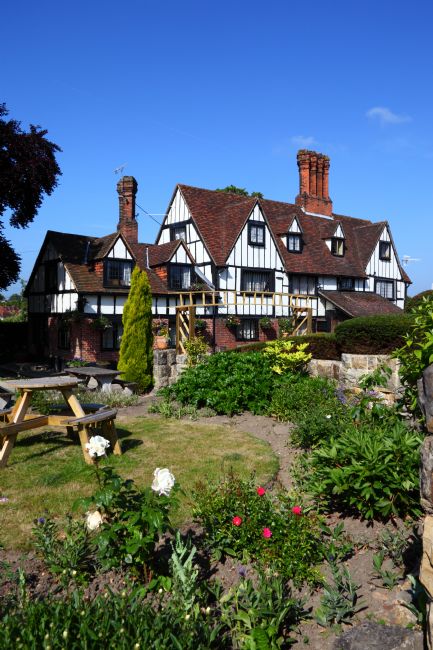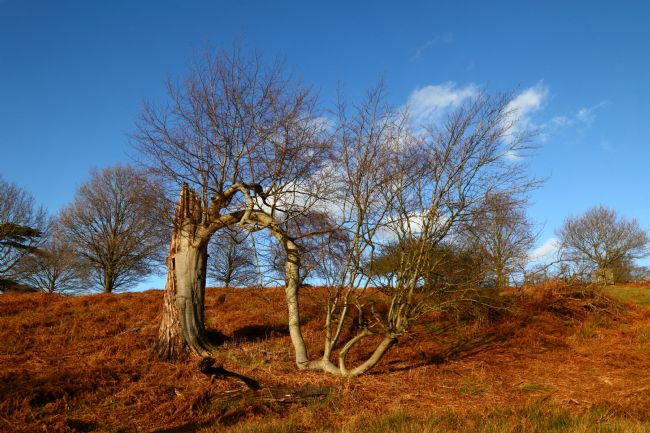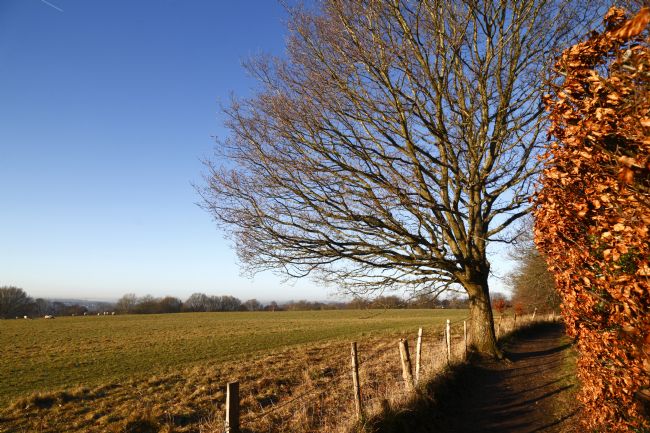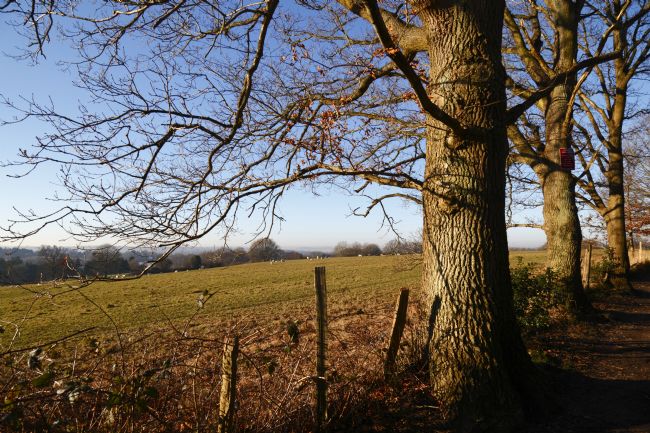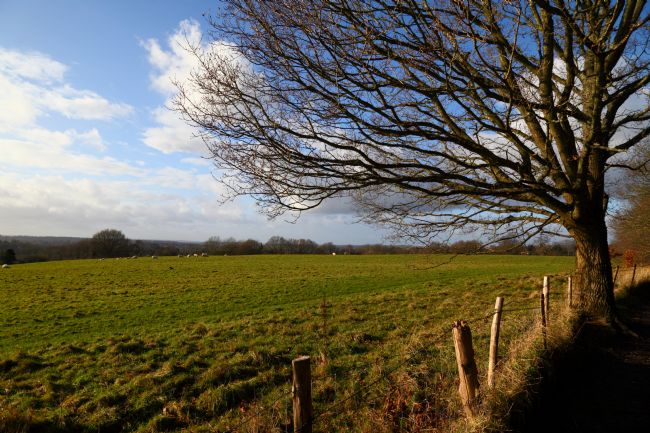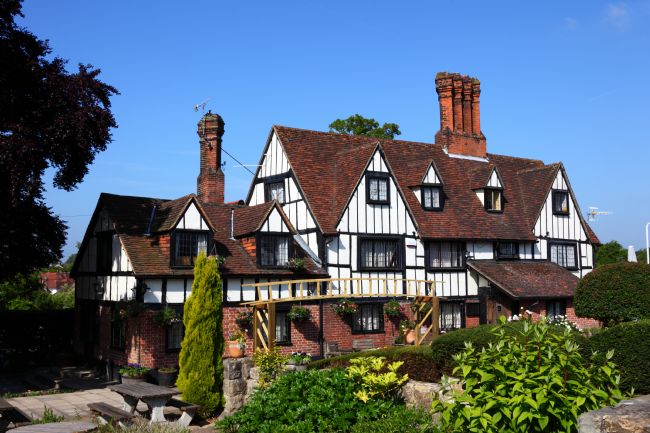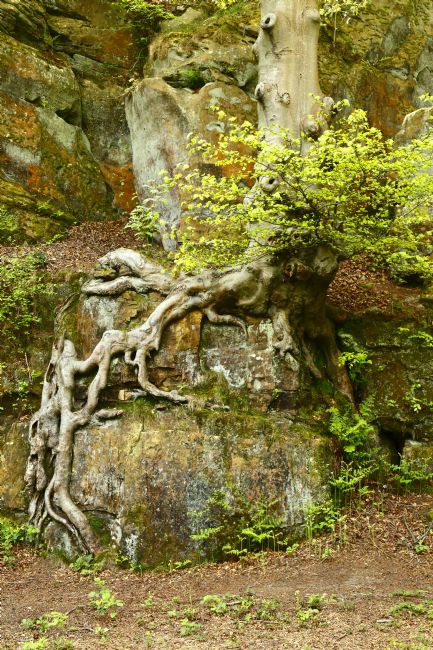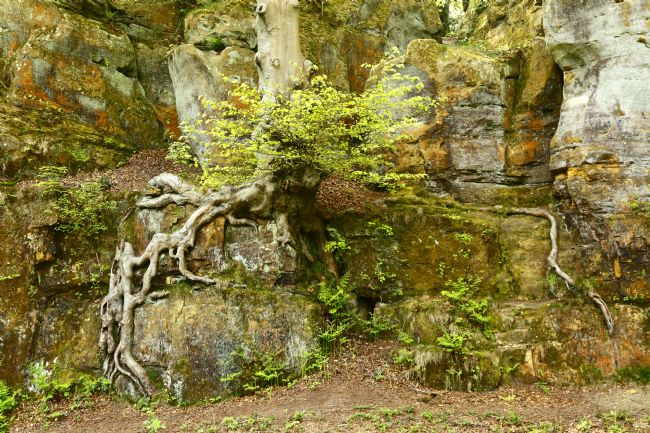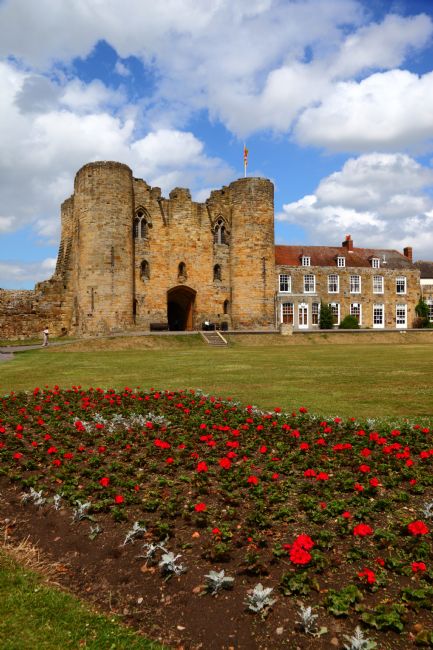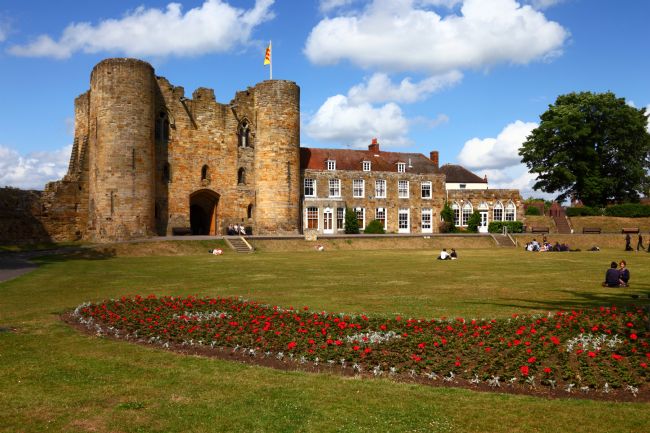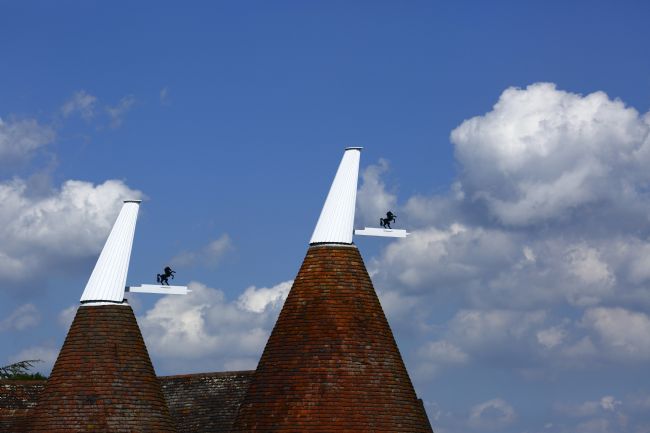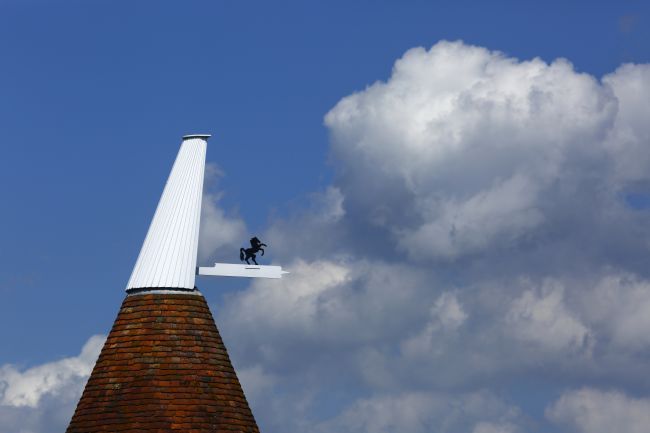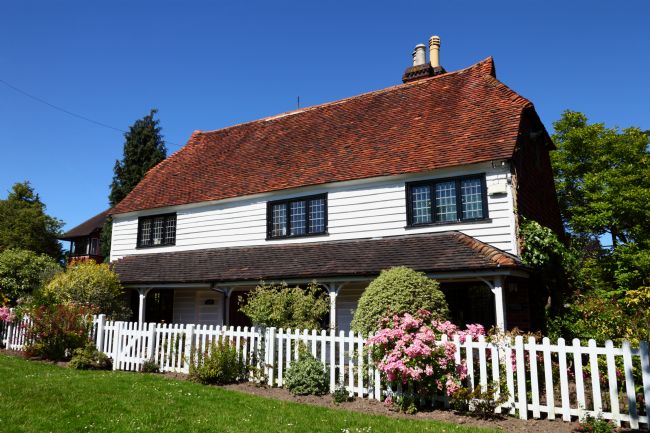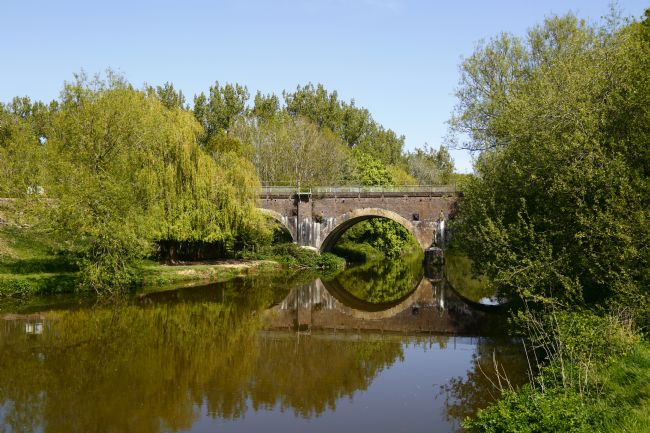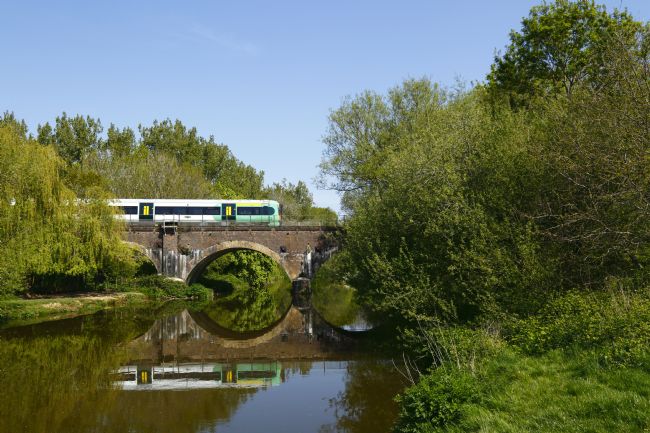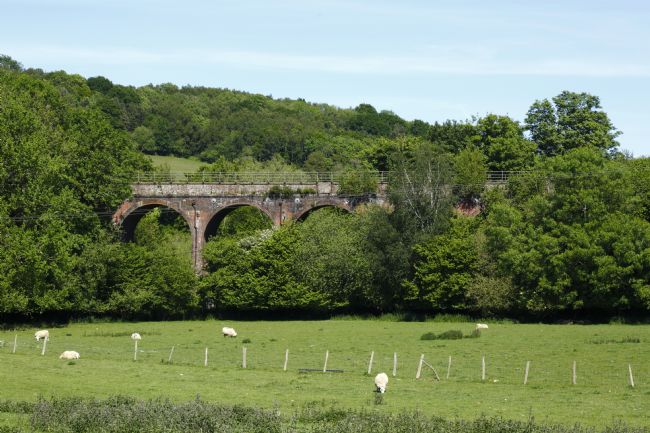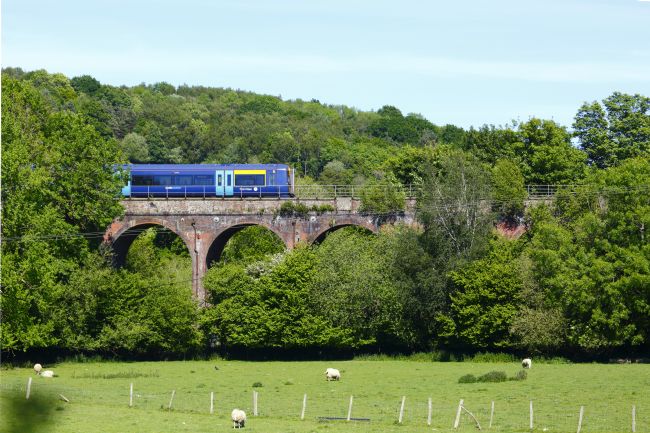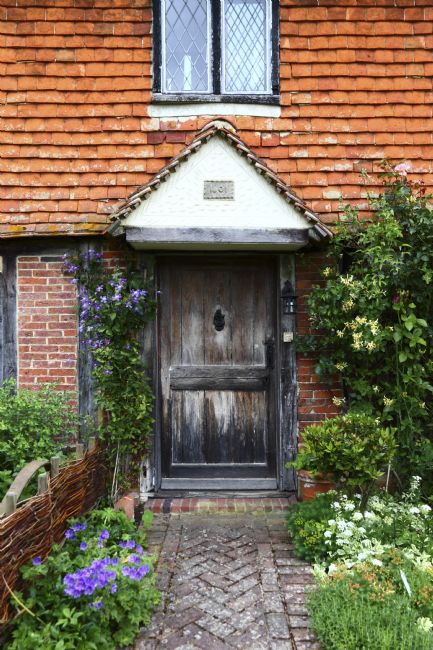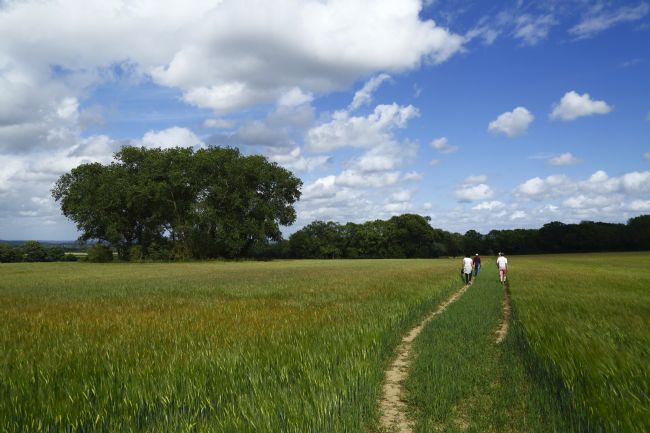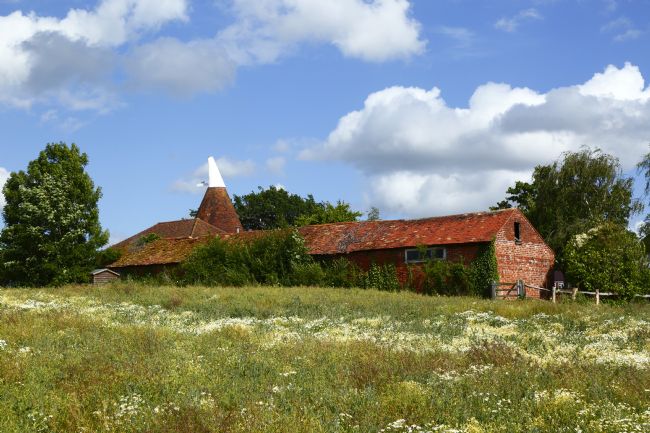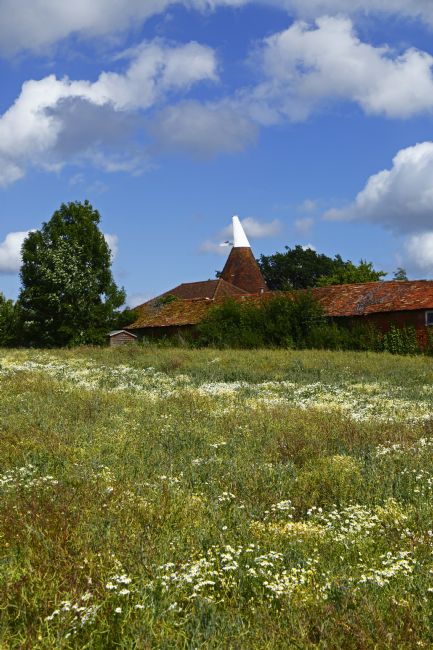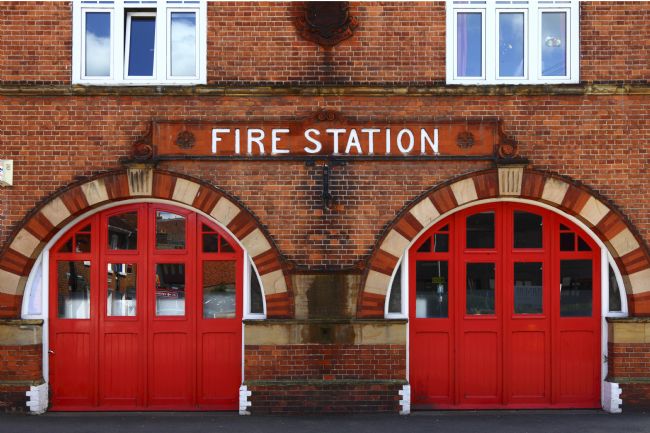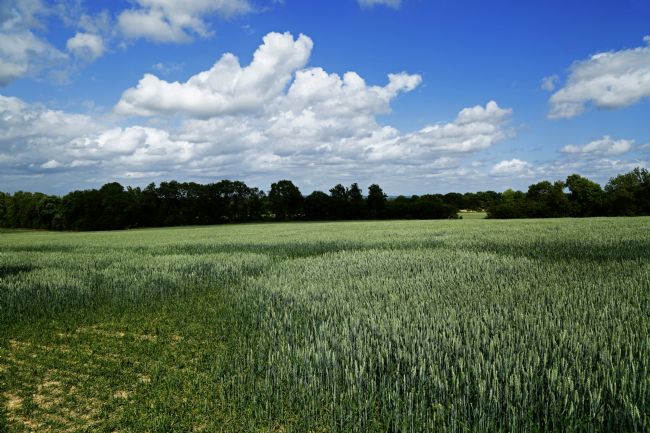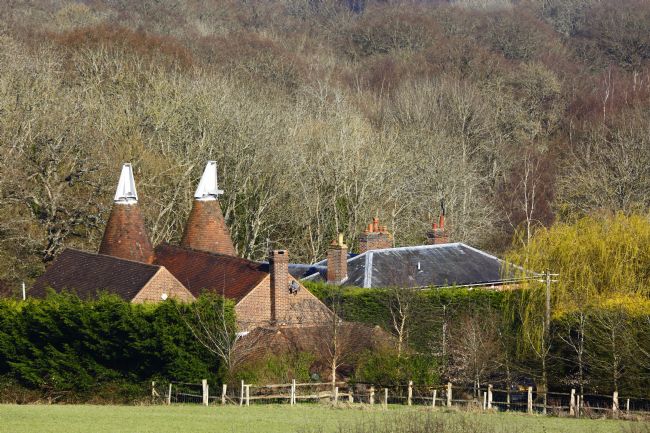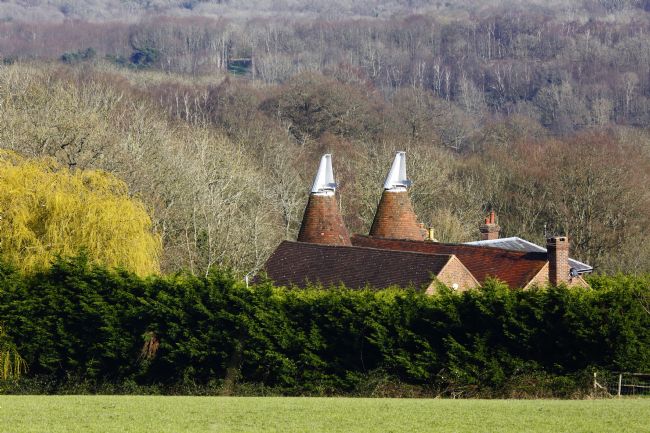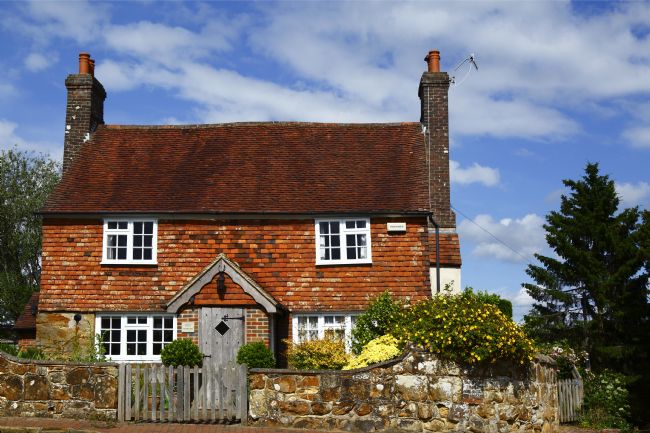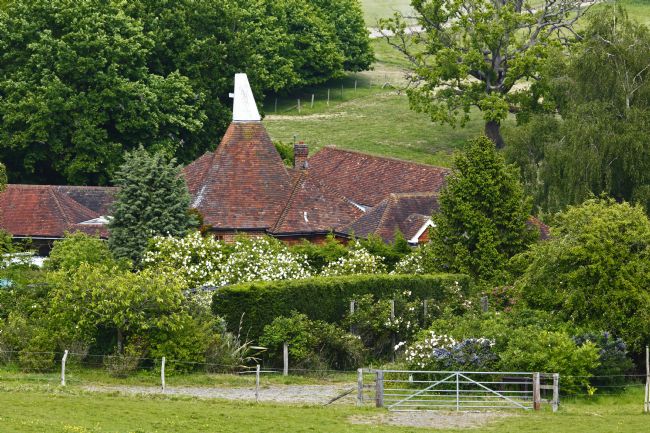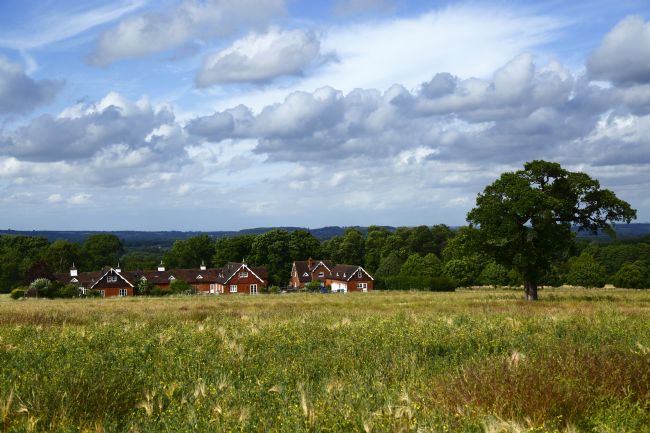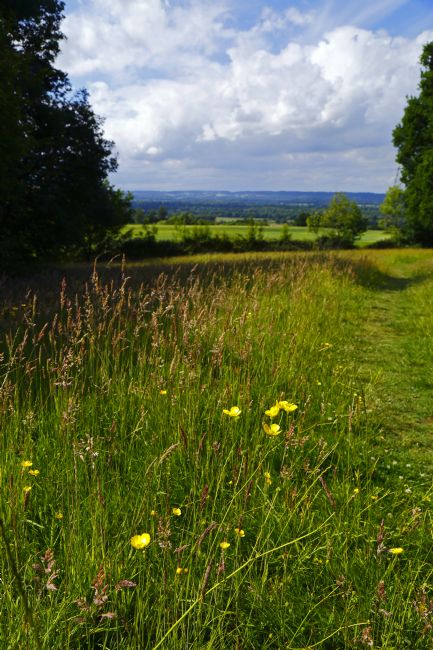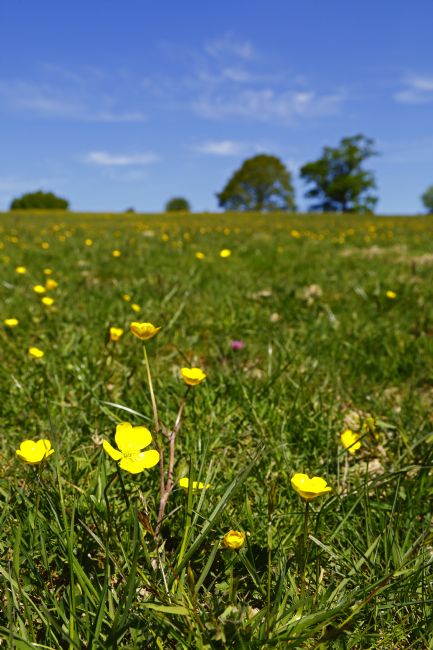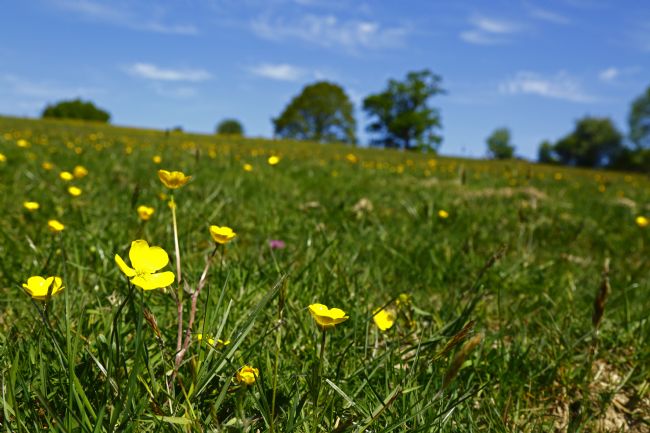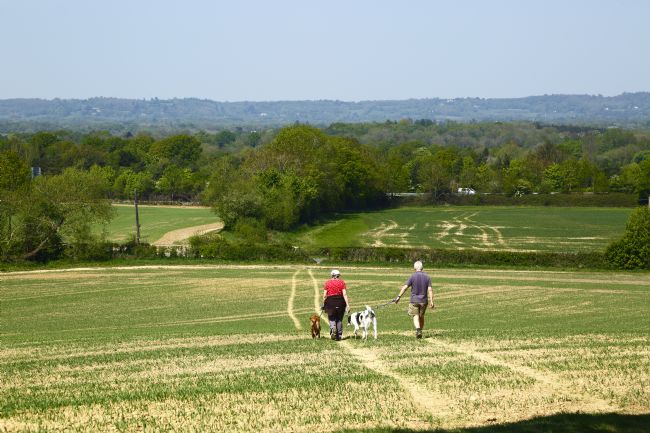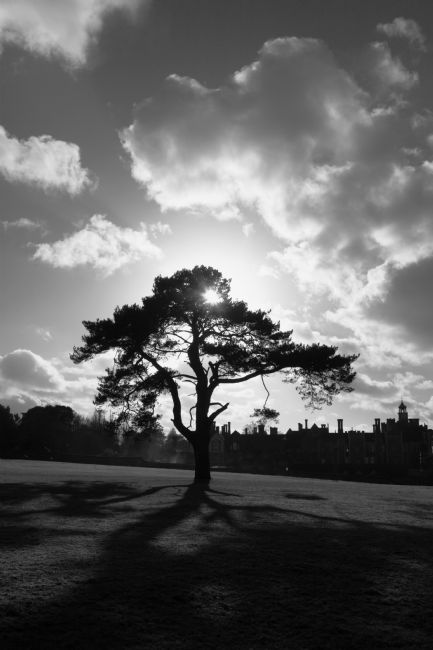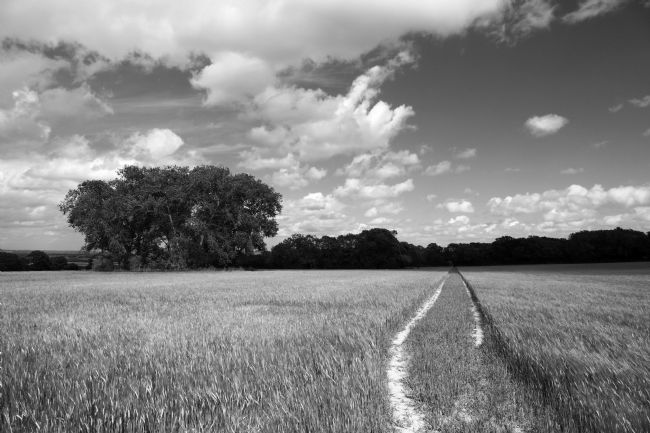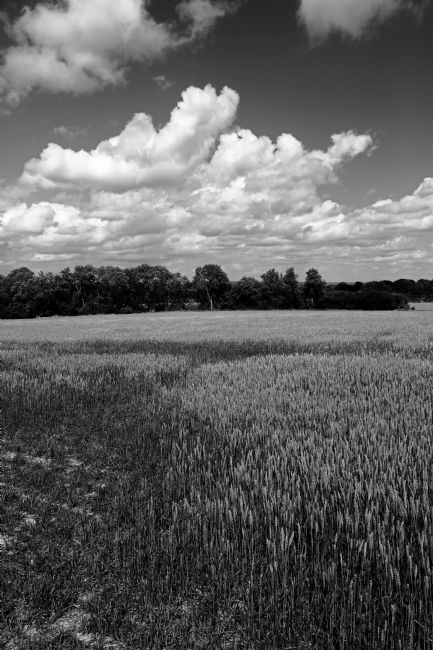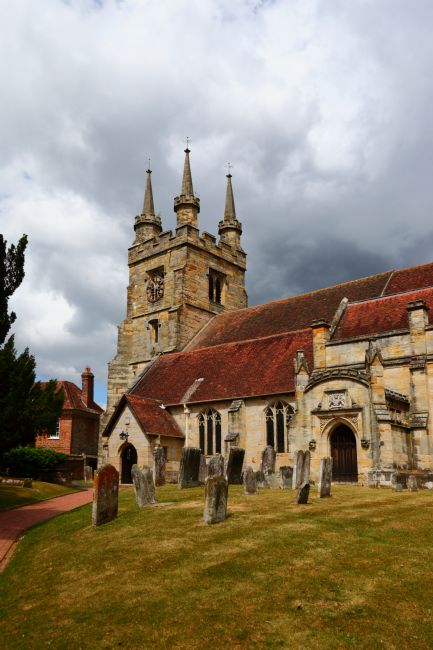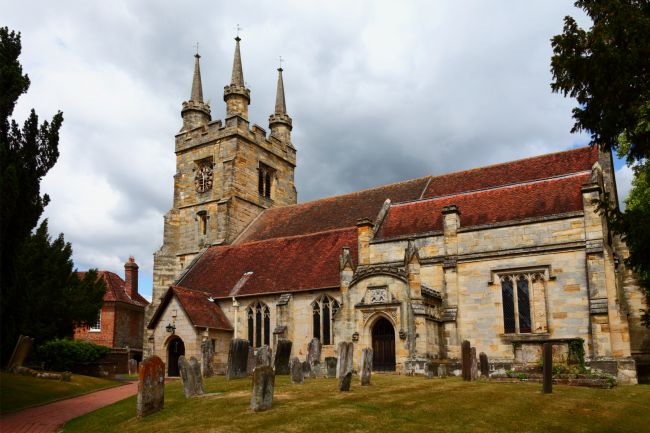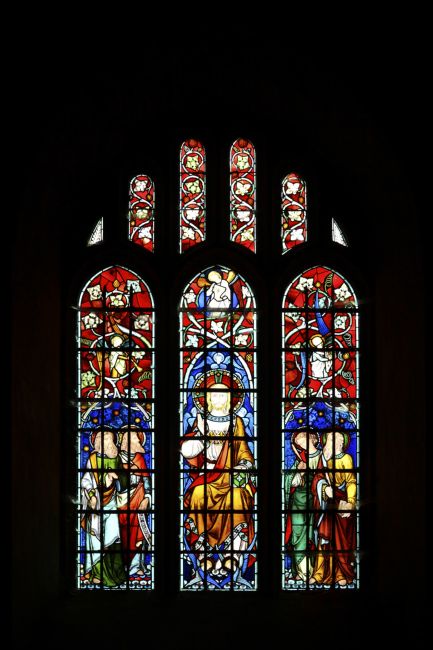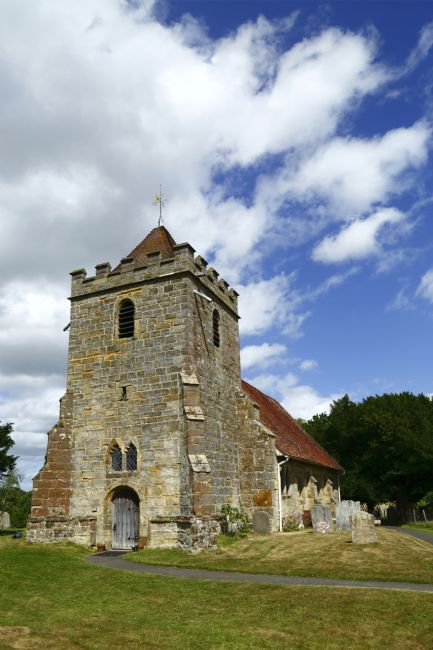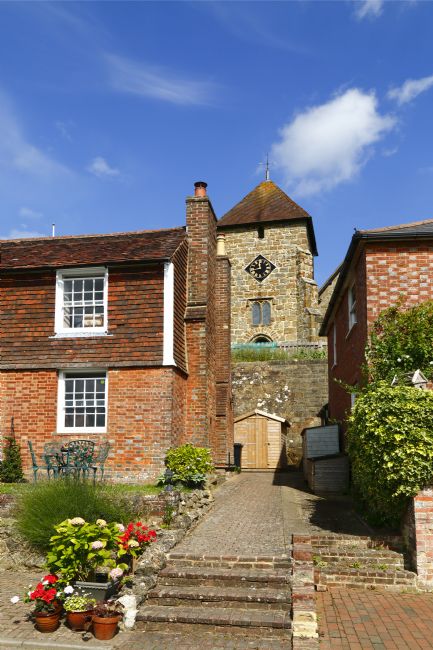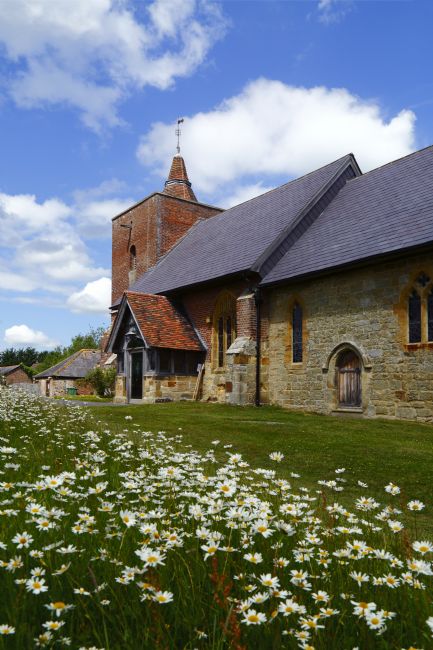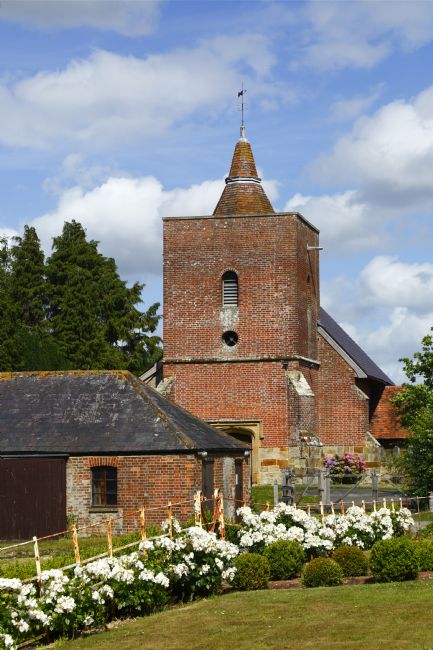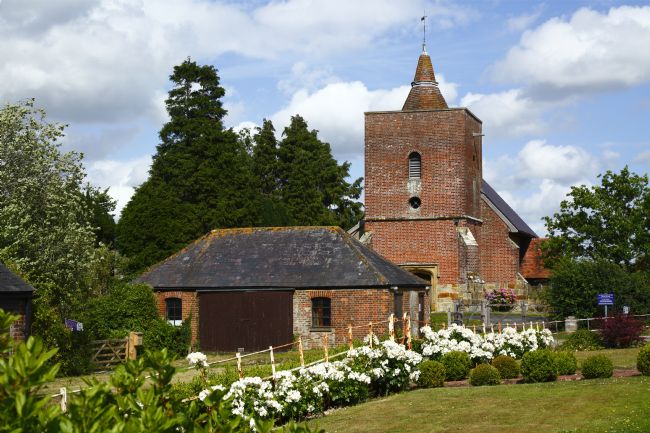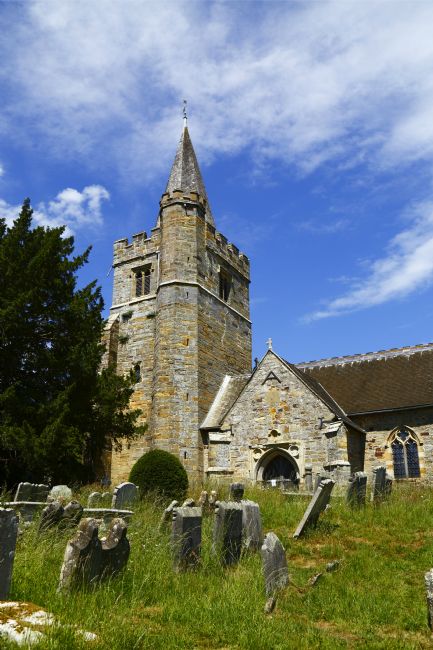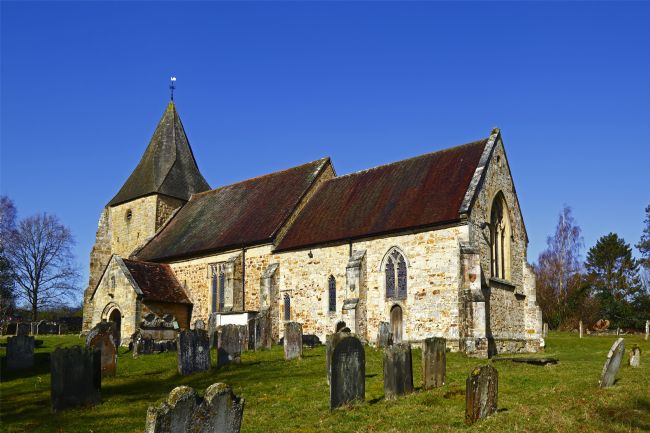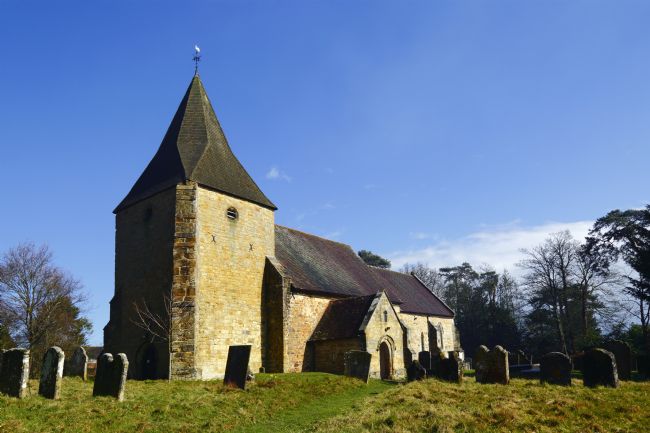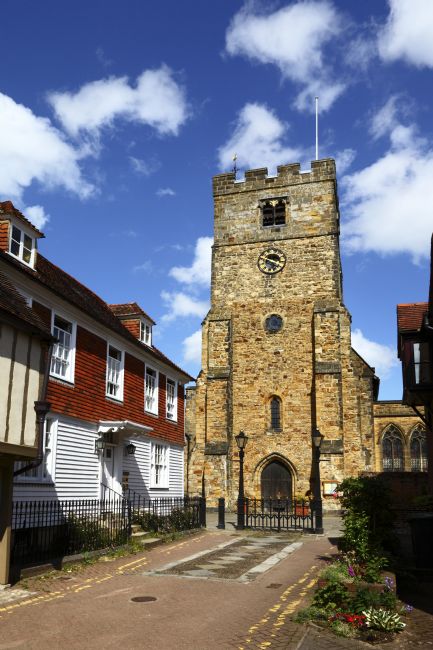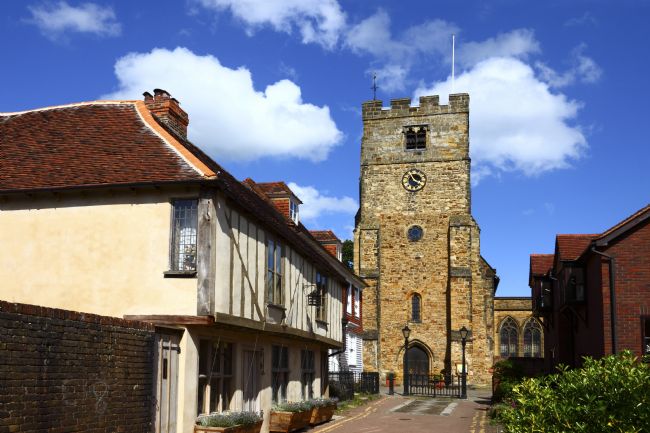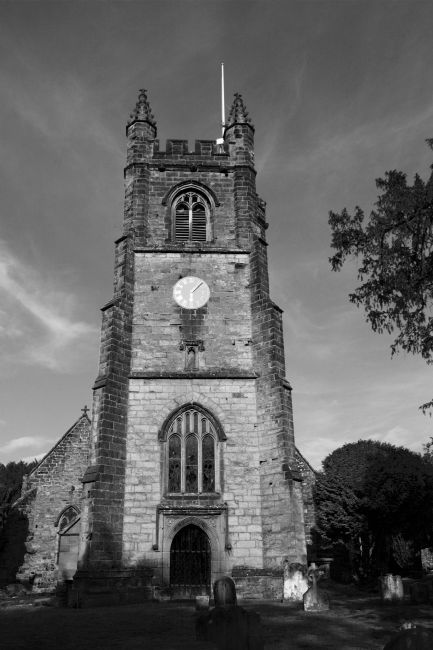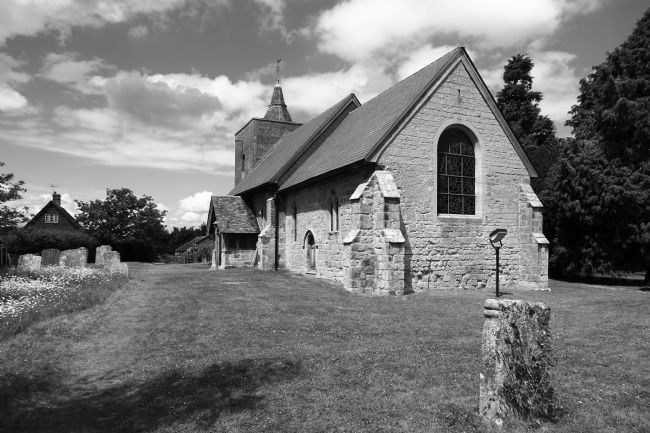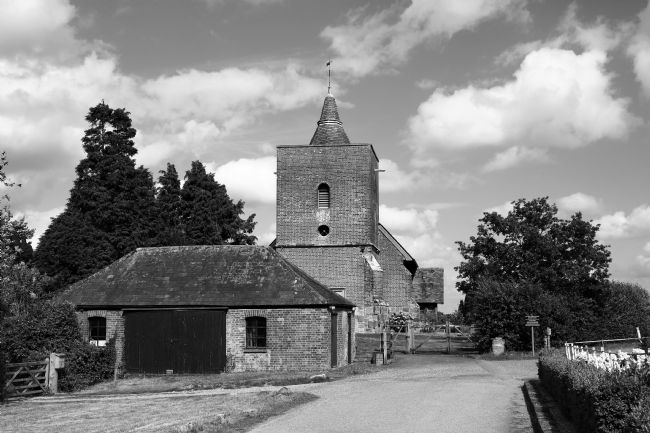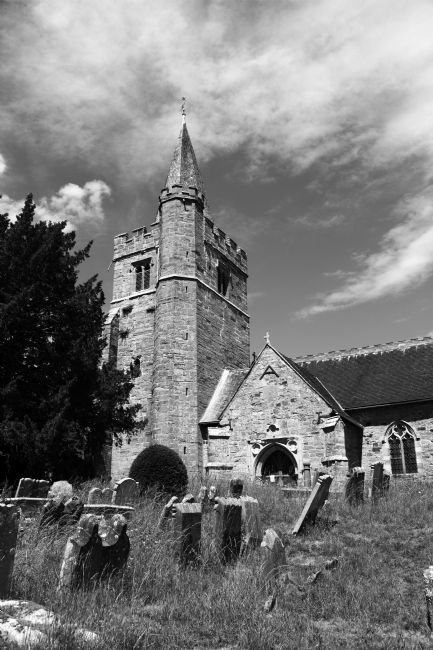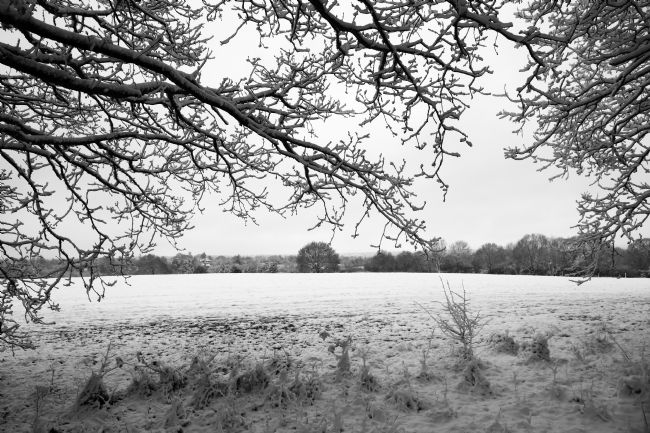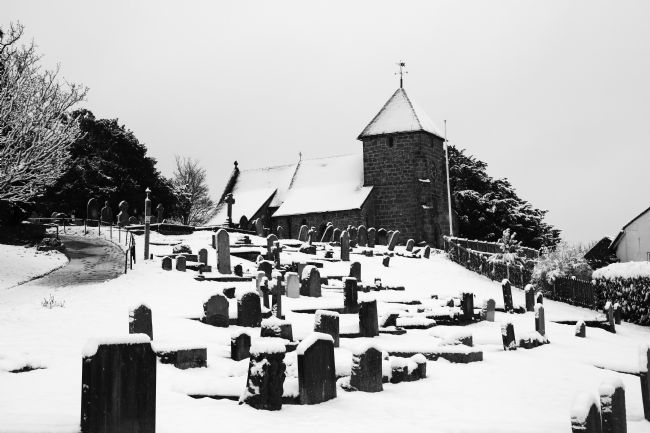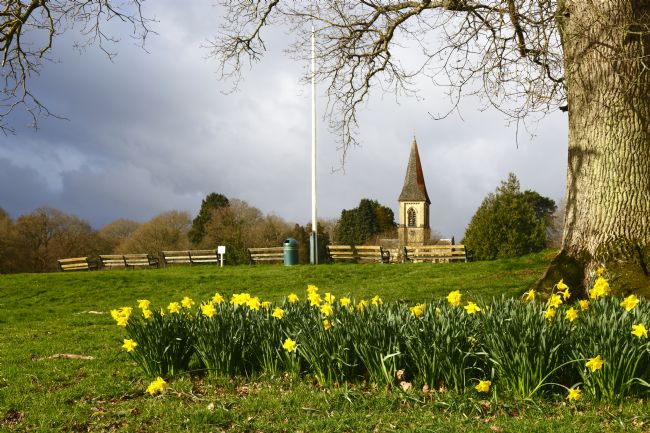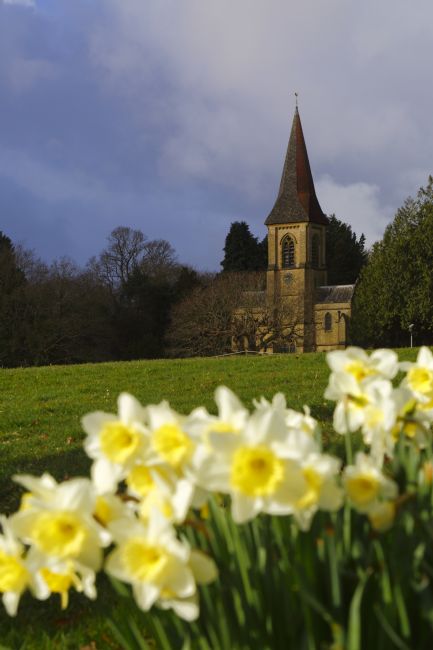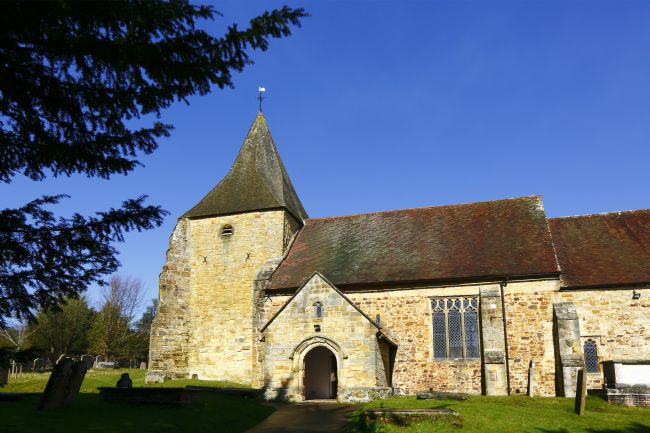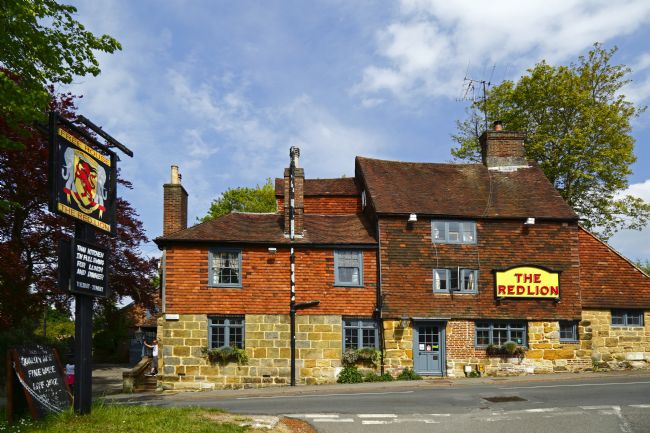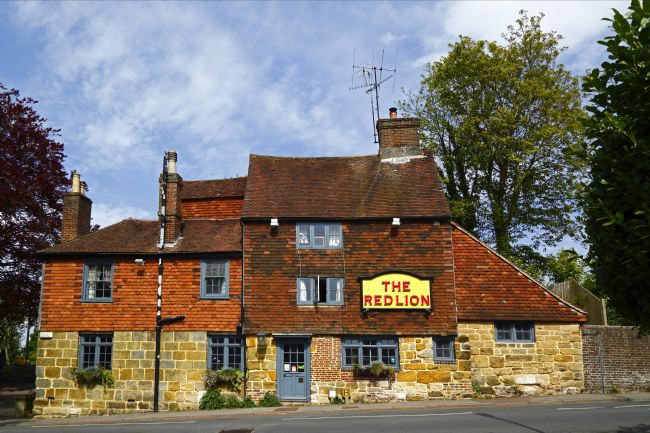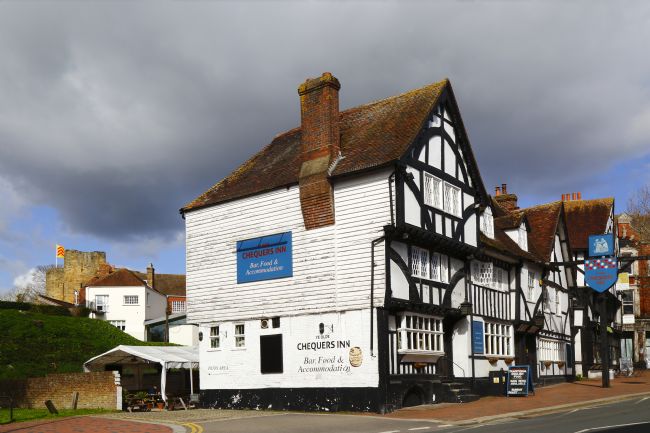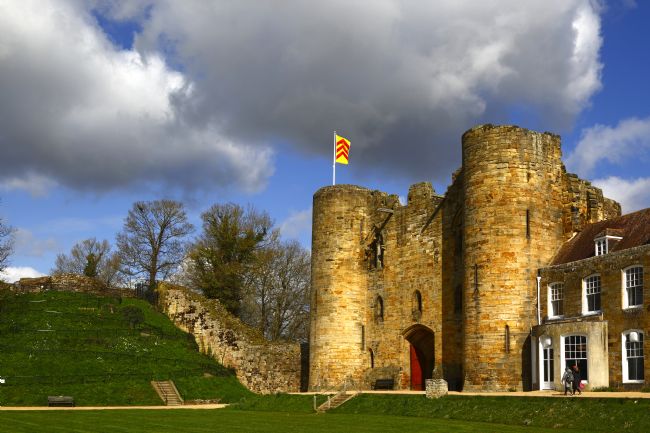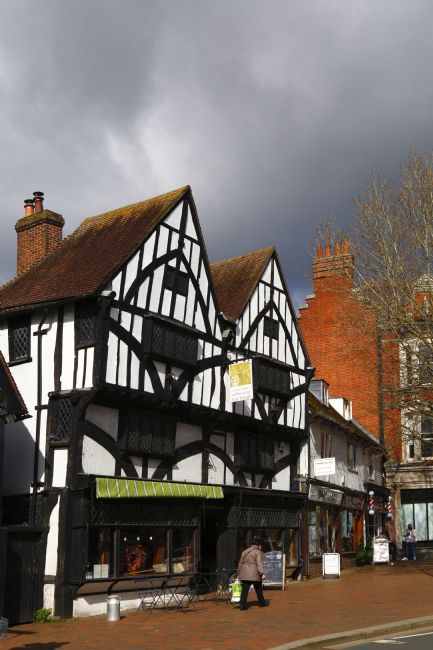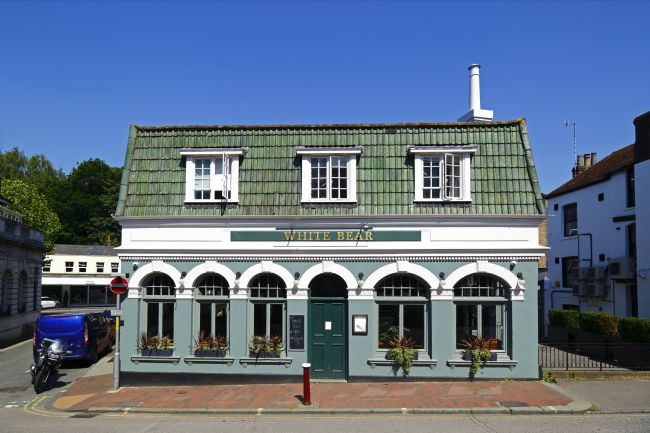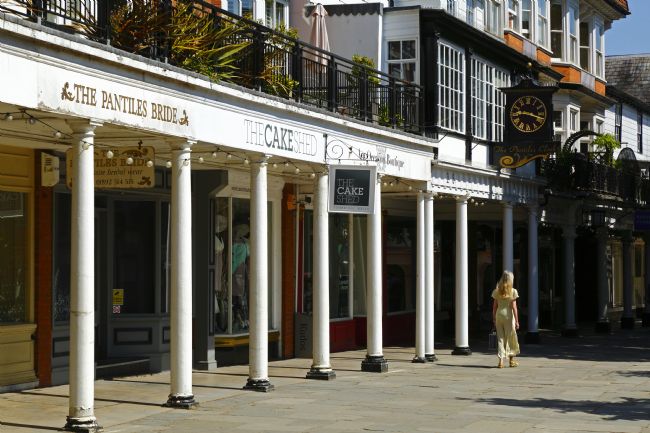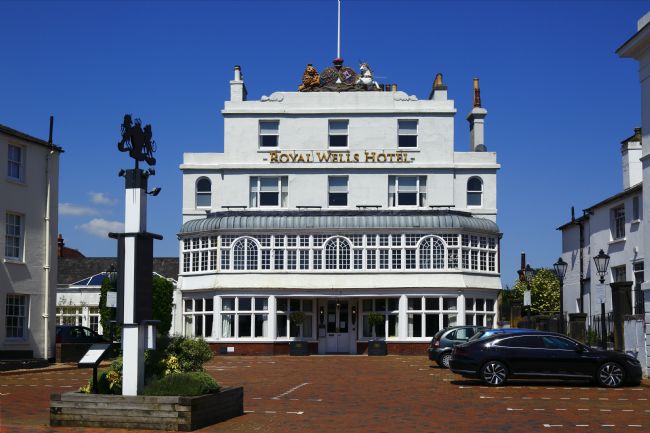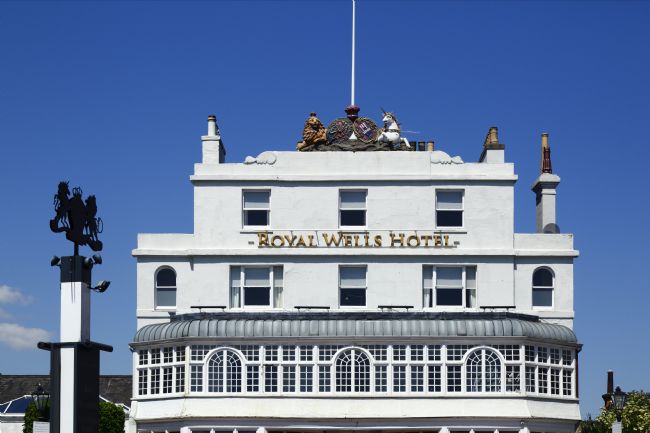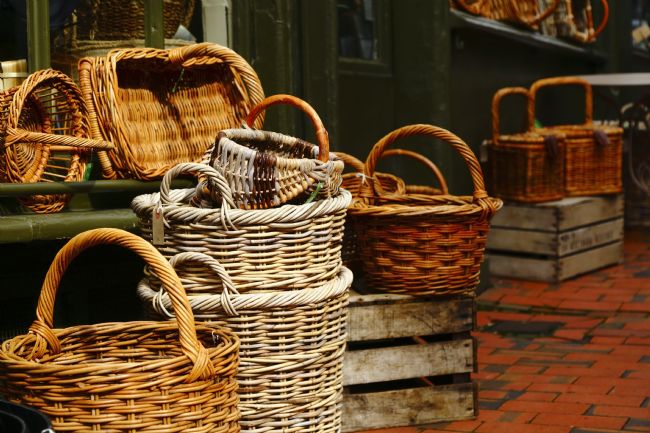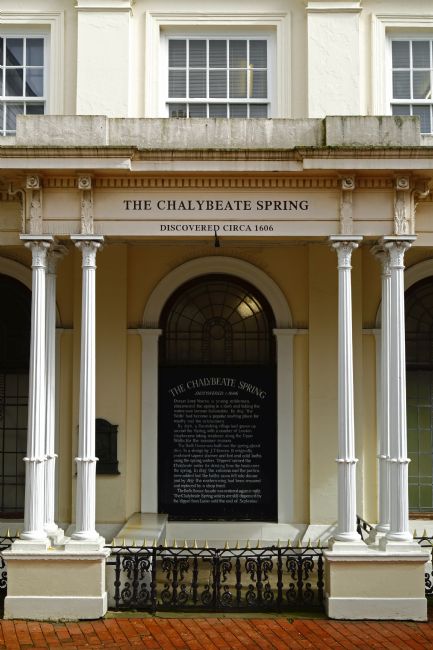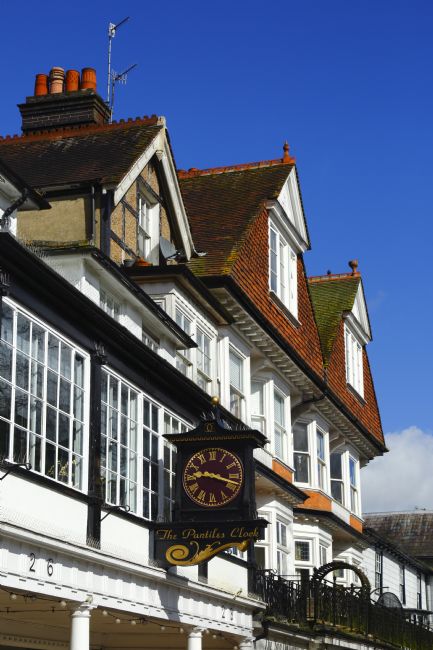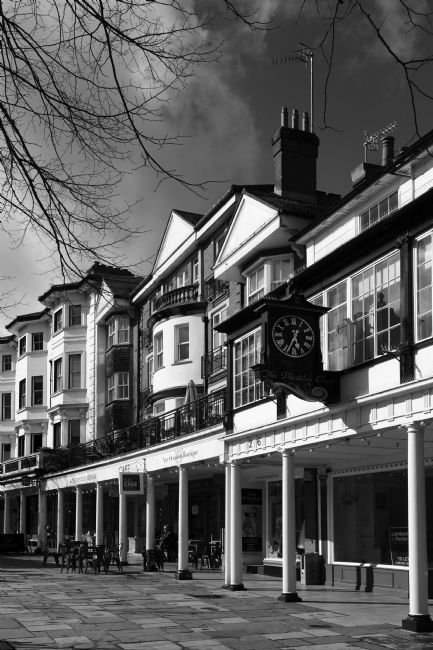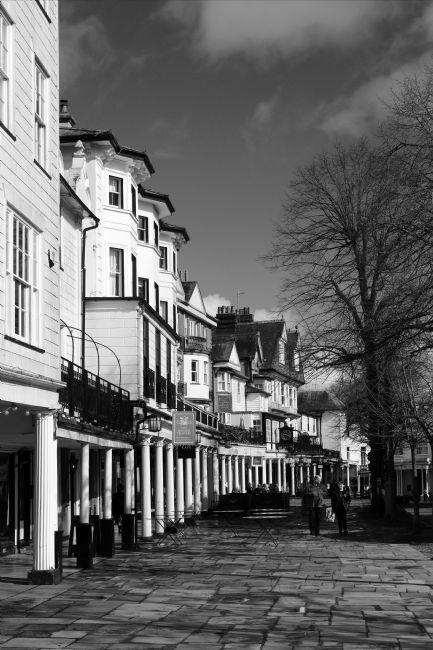This building in Southborough near Tunbridge Wells used to house The Weavers pub / restaurant and is a fine example of a Wealden Hall farmhouse. It dates from the 16th Century though there have been more recent additions and modifications; it is a Grade II listed building. This style of farmhouse was commonly built in southeast England at the time, especially in the Weald of Kent and Sussex.
This unusually shaped beech tree (Fagus sylvatica) is in Knole Park, Sevenoaks, Kent. The main trunk broke off during the Great Storm of October 1987 which blew over, damaged or destroyed thousands of trees in southern England. The Sevenoaks area was particularly affected, the town also lost 6 of the 7 oaks for which it is named. Autumnal bracken (Pteridium aquilinum) always adds some glorious colour to autumn and winter landscapes!
A typical country view along the Wealdway long distance footpath between Southborough and Bidborough near Tunbridge Wells, Kent. This section could also be included in the High Weald Walk, another popular route. Copper beech trees (Fagus sylvatica purpurea, an ornamental version of the European beech Fagus sylvatica) form the hedge on the right.
A typical country view along the Wealdway long distance footpath between Southborough and Bidborough near Tunbridge Wells, Kent. This section could also be included in the High Weald Walk, another popular route. The golden late afternoon winter sunlight really enhances the patterns and textures of the mature tree trunks.
A typical country view along the Wealdway long distance footpath between Southborough and Bidborough near Tunbridge Wells, Kent. This section could also be included in the High Weald Walk, another popular route. Winter is a wonderful time for tree lovers, the lack of foliage really allows you to appreciate their wonderful shapes and branches and they add loads of character to the landscapes.
This building in Southborough near Tunbridge Wells used to house The Weavers pub / restaurant and is a fine example of a Wealden Hall farmhouse. It dates from the 16th Century though there have been more recent additions and modifications; it is a Grade II listed building. This style of farmhouse was commonly built in southeast England at the time, especially in the Weald of Kent and Sussex.
I found these fantastic European or common beech tree (Fagus sylvatica) roots on Rusthall Common near Tunbridge Wells in Kent. This part of the High Weald is noted for its sandstone rock outcrops as well as its ancient woodlands. This ancient root system had spread over and into crevasses and joints in the rock almost like some alien growth, it's amazing what nature can do over time!
I found these fantastic European or common beech tree (Fagus sylvatica) roots on Rusthall Common near Tunbridge Wells in Kent. This part of the High Weald is noted for its sandstone rock outcrops as well as its ancient woodlands. This ancient root system had spread over and into crevasses and joints in the rock almost like some alien growth, it's amazing what nature can do over time!
I found these fantastic European or common beech tree (Fagus sylvatica) roots on Rusthall Common near Tunbridge Wells in Kent. This part of the High Weald is noted for its sandstone rock outcrops as well as its ancient woodlands. This ancient root system had spread over and into crevasses and joints in the rock almost like some alien growth, it's amazing what nature can do over time!
Tonbridge Castle's twin towered gatehouse is one of the finest of its kind in England and was completed in 1260. The neighbouring mansion was added in the 1790s. Tonbridge has long been an important crossing point on the River Medway, the remains of an earlier motte and bailey fort also stand on the site (out of the left side of this shot). Images that are closer crops without the flower bed are also available, please message if interested!
Tonbridge Castle's twin towered gatehouse is one of the finest of its kind in England and was completed in 1260. The neighbouring mansion was added in the 1790s. Tonbridge has long been an important crossing point on the River Medway, the remains of an earlier motte and bailey fort also stand on the site (out of the left side of this shot). Images that are closer crops without the flower bed are also available, please message if interested!
People enjoy a summer´s afternoon in the gardens next to Tonbridge Castle, Kent. The castle's twin towered gatehouse is one of the finest of its kind in England and was completed in 1260. The neighbouring mansion was added in the 1790s. Tonbridge has long been an important crossing point on the River Medway, the remains of an earlier motte and bailey fort also stand on the site (out of the left side of this shot).
Dramatic cumulus clouds rise behind a pair of oast houses, seen from the Wealdway near Haysden in the Medway valley, Kent. Oast houses are particularly associated with Kent and are also called hop kilns as they were built to dry hops. Hops were once the most important crop in the county, now they are hardly grown and many oasts have been converted into homes. A rampant white horse is one of the symbols of Kent and features on the county coat of arms. The black horse here has presumably been painted to contrast with the white cowl. Similar images with different clouds are available, please message if interested!
A close up of an oast house cowl seen from the Wealdway near Haysden in the Medway valley , Kent. Oast houses are particularly associated with Kent and are also called hop kilns as they were built to dry hops. Hops were once the most important crop in the county, now they are hardly grown and many oasts have been converted into homes. A rampant white horse is one of the symbols of Kent and features on the county coat of arms. The black horse here has presumably been painted to contrast with the white cowl. Similar images with different clouds and in vertical format are available, please message if interested!
These white painted weatherboarded cottages are characteristic of south east England. This one is Stuart Cottage close to Southborough Common near Tunbridge Wells in the Weald of Kent. It is one of the oldest buildings in Southborough and a Grade II Listed building, parts date from the 16th Century.
A beautiful late spring / early summer´s day next to the River Medway at Haysden near Tonbridge, Kent. The bridge carries the Tonbridge to Redhill railway line, part of the first line from London to Dover and built in 1836 by the South Eastern Railway. The main line now takes a more direct route from London to Tonbridge, this route now offers a cross country service and connections to Gatwick Airport.
An electric passenger train operated by Southern (a subsidiary of Govia) crosses the River Medway at Haysden shortly before arriving at Tonbridge. This line, which runs from Tonbridge to Redhill, was built in 1836 by the South Eastern Railway as part of the first railway from London to Dover. A newer, more direct main line route now carries most of the rail traffic from London to Tonbridge; this line is now more used as a local service with connections to Gatwick Airport.
Sheep grazing in fields near the impressive but little known Colebrook or Southborough Viaduct at the bottom of Powder Mill Lane near Southborough, Kent. It was built in 1845 when the railway from Tonbridge to Tunbridge Wells was constructed and has 26 arches. The stream in the valley is a tributary of the River Medway, the viaduct is one of the main landmarks on the High Weald Walk footpath that passes through the picturesque countryside in this part of Kent.
Sheep grazing in fields near the impressive but little known Colebrook or Southborough Viaduct at the bottom of Powder Mill Lane near Southborough, Kent. It was built in 1845 when the railway from Tonbridge to Tunbridge Wells was constructed and has 26 arches. The stream in the valley is a tributary of the River Medway, the viaduct is one of the main landmarks on the High Weald Walk footpath that passes through the picturesque countryside in this part of Kent.
A Southern Rail electric train crosses the impressive but little known Colebrook or Southborough Viaduct at the bottom of Powder Mill Lane near Southborough, Kent, England. It was built in 1845 when the railway from Tonbridge to Tunbridge Wells was constructed and has brick 26 arches of differing heights. The railway continues to Hastings on the south coast and is an important commuter route to London.
Sheep grazing in fields near the impressive but little known Colebrook or Southborough Viaduct at the bottom of Powder Mill Lane near Southborough, Kent. It was built in 1845 when the railway from Tonbridge to Tunbridge Wells was constructed and has 26 arches. The stream in the valley is a tributary of the River Medway, the viaduct is one of the main landmarks on the High Weald Walk footpath that passes through the picturesque countryside in this part of Kent.
The front door of a typical old Wealden cottage in Chiddingstone, Kent. The vertical / hanging tiling on the upper storey is a very distinctive feature of cottages in the region.
A typical country scene in the Weald of Kent in early summer, a path through a field of young wheat near the small village of Tudeley. Tudeley lies on the edge of the Medway Valley between Tonbridge and Paddock Wood and the area is still remarkably rural given its proximity to these important railway towns. This may all change in the near future as Tunbridge Wells Borough Council has plans to build over 4,000 new houses on green belt land here which will almost certainly destory its charm and beauty. To find out more about these plans and campaigns against them please visit the Save Capel website: savecapel.com
Facebook Page: savecapel2020
Twitter: SaveCapel
A black and white version of this image is also available, please message if you are interested!
Hikers enjoy a beautiful early summer's day exploring footpaths near the small village of Tudeley in the Weald of Kent. Tudeley lies on the edge of the Medway Valley between Tonbridge and Paddock Wood and the area is still remarkably rural given its proximity to these important railway towns. This may all change in the near future as Tunbridge Wells Borough Council has plans to build over 4,000 new houses on green belt land here which will almost certainly destory its charm and beauty. To find out more about these plans and campaigns against them please visit the Save Capel website: savecapel.com
Facebook Page: savecapel2020
Twitter: SaveCapel
A detail of the lattice window of a typical old brick and timber framed Wealden cottage in Chiddingstone, Kent. The vertical / hanging tiling on the upper storey is a distinctive feature of cottages in the region.
A view across a wildflower meadow to an oast house, seen from the High Weald Walk near Tudeley, Kent. Oast houses are particularly associated with Kent and are also called hop kilns as they were built to dry hops, once the most important crop in the county. The Tudeley area is still very rural with plenty of beautiful countryside under wide open skies. This may all change in the near future as Tunbridge Wells Borough Council has plans to build over 4,000 new houses on green belt land here which will almost certainly destory its charm and beauty. To find out more about these plans and campaigns against them please visit the Save Capel website: savecapel.com
Facebook Page: savecapel2020
Twitter: SaveCapel
A view across a wildflower meadow to an oast house, seen from the High Weald Walk near Tudeley, Kent. Oast houses are particularly associated with Kent and are also called hop kilns as they were built to dry hops, once the most important crop in the county. The Tudeley area is still very rural with plenty of beautiful countryside under wide open skies. This may all change in the near future as Tunbridge Wells Borough Council has plans to build over 4,000 new houses on green belt land here which will almost certainly destory its charm and beauty. To find out more about these plans and campaigns against them please visit the Save Capel website: savecapel.com
Facebook Page: savecapel2020
Twitter: SaveCapel
Tonbridge's distinctive historic late Victorian period fire station in Bank Street officially opened on 12th April 1902 and was in continuous use until 1985. After a period of disuse it has been renovated and in 2015 opened to the public as an events centre with bars, restaurants and an art gallery.
View over a field of young wheat in early summer near the small hamlet of Capel in the Weald of Kent. A black and white version of this image is also available, please message if you would prefer a print in monochrome! Capel lies on the edge of the Medway Valley and has long been an important agricultural area. Despite being close to the important railway towns of Tonbridge and Paddock Wood it is still very rural and it is easy to enjoy peace and quiet in picturesque countryside under wide open skies. This may all change in the near future as Tunbridge Wells Borough Council has plans to build over 4,000 new houses nearby on green belt land which will almost certainly destroy its charm and beauty. To find out more about these plans and campaigns against them please visit the Save Capel website: savecapel.com
Facebook: savecapel2020
Twitter: SaveCapel
Oast houses are particularly associated with Kent and are also called hop kilns as they were built to dry hops, once the most important crop in the county. Their distinctive conical roofs and cowls are still a feature of the region. This oast is in the High Weald region between Tonbridge and Southborough, the surrounding woodlands are just starting to develop buds in early spring.
Oast houses are particularly associated with Kent and are also called hop kilns as they were built to dry hops, once the most important crop in the county. Their distinctive conical roofs and cowls are still a feature of the region. This oast is in the High Weald region between Tonbridge and Southborough, the surrounding woodlands are just starting to develop buds in early spring.
A group of ox-eye / oxeye daisies (Leucanthemum vulgare) in flower on the shore of Haysden Water, a large lake that is part of Haysden Country Park, Kent. The lake lies next to the River Medway just upstream of the Leigh flood barrier, which protects nearby Tonbridge from flooding. It is a popular area for outdoor recreation including fishing and sailing.
A typical Wealden cottage in Bidborough, a small village between Tonbridge and Tunbridge Wells in Kent. The wall and part of the lower story are made of the local yellow sandstone; the upper floor the vertical / hanging tiling typical of the region.
Oast houses are particularly associated with Kent and are also called hop kilns as they were built to dry hops, once the most important crop in the county. Many have now been converted into homes as few hops are grown in the region. This oast is at Honnington Farm near the High Weald Walk route between Southborough and Tonbridge
Views from the High Weald Walk footpath between Tudeley and Tonbridge in Kent, looking north towards the Medway Valley. This section of the route passes through what used to be part of the huge Somerhill House Estate and Park. The buildings date from the 19th century and used to be the stables and workers houses of the stud farm. A similar image with a tighter crop (showing half the left hand building and less sky is also available, please message if interested!
Wildflower meadows on Bidborough Ridge in Kent, with the Medway Valley and North Downs visible in the distance. The footpath is an alternative branch of the Wealdway long distance footpath between the Ridge down to the valley. The yellow flowers are buttercups, left uncut these fields often have large numbers of native grass and flower species. A horizontal / landscape format version is also available, please message if interested!
Buttercups (Ranunculus family) in a wildflower meadow in the Weald of Kent in early summer. There are quite a number of buttercup species in the UK, these are probably creeping buttercups (Ranunculus repens), one of the most common. This shot was taken on the Wealdway long distance footpath between Southborough and Bidborough.
Buttercups (Ranunculus family) in a wildflower meadow in the Weald of Kent in early summer. There are quite a number of buttercup species in the UK, these are probably creeping buttercups (Ranunculus repens), one of the most common. This shot was taken on the Wealdway long distance footpath between Southborough and Bidborough.
A couple walking their dogs on a beautiful summer's day on the Wealdway long distance footpath in Kent. This section of the route descends from Bidborough Ridge to the Medway Valley near Tonbridge; the North Downs are visible in the distance.
A view across a field of wheat / corn towards a typical Wealden cottage near the small village of Capel in Kent. The white painted wooden weatherboards are common in the region, both on just the upper storey (such as in this image) or the whole building.
A black and white shot of a backlit pine tree in Knole Park, a deer park just outside Sevenoaks, Kent. Knole House in the background is the largest stately home in Kent and one of the largest in England. The oldest parts date from the 15th century with major expansions in the 16th and especially the early 17th century. The park used to be a popular hunting ground for the English monarchy; now much of it is open to the public and a lovely area for walking.
A black and white shot of a backlit pine tree in Knole Park, a deer park just outside Sevenoaks, Kent. The park used to be a popular hunting ground for the English monarchy; now much of it is open to the public and a lovely area for walking. Knole House in the background is the largest stately home in Kent and one of the largest in England. The oldest parts date from the 15th century with major expansions in the 16th and especially the early 17th century.
A black and white shot of a typical country scene in the Weald of Kent in early summer, a path through a field of young wheat near the small village of Tudeley. Tudeley lies on the edge of the Medway Valley between Tonbridge and Paddock Wood and the area is still remarkably rural given its proximity to these important railway towns. This may all change in the near future as Tunbridge Wells Borough Council has plans to build over 4,000 new houses on green belt land here which will almost certainly destory its charm and beauty. To find out more about these plans and campaigns against them please visit the Save Capel website: savecapel.com
Facebook Page: savecapel2020
Twitter: SaveCapel
A colour version of this image is also available, please message if you are interested!
A view in black and white across a wildflower meadow to an oast house, seen from the High Weald Walk near Tudeley, Kent. Oast houses are particularly associated with Kent and are also called hop kilns as they were built to dry hops, once the most important crop in the county. The Tudeley area is still very rural with plenty of beautiful countryside under wide open skies. This may all change in the near future as Tunbridge Wells Borough Council has plans to build over 4,000 new houses on green belt land here which will almost certainly destory its charm and beauty. To find out more about these plans and campaigns against them please visit the Save Capel website: savecapel.com
Facebook Page: savecapel2020
Twitter: SaveCapel
A view over a field of young wheat in early summer near the small hamlet of Capel in the Weald of Kent. A colour version of this image is also available, please message if interested! Capel lies on the edge of the Medway Valley and has long been an important agricultural area. Despite being close to the important railway towns of Tonbridge and Paddock Wood it is still very rural and it is easy to enjoy peace and quiet in picturesque countryside under wide open skies. This may all change in the near future as Tunbridge Wells Borough Council has plans to build over 4,000 new houses nearby on green belt land which will almost certainly destroy its charm and beauty. To find out more about these plans and campaigns against them please visit the Save Capel website: savecapel.com
Facebook: savecapel2020
Twitter: SaveCapel
A black and white image of a group of ox-eye / oxeye daisies (Leucanthemum vulgare) in flower on the shore of Haysden Water, a large lake that is part of Haysden Country Park, Kent. The lake lies next to the River Medway just upstream of the Leigh flood barrier, which protects nearby Tonbridge from flooding. It is a popular area for outdoor recreation including fishing and sailing.
The church of St John the Baptist in Penshurst in the Weald of Kent near Tunbridge Wells dates from the 12th century, the tower was added in the 15th century. Like many churches in the area it was built using the local yellow sandstone typical of the High Weald region.
The church of St John the Baptist in Penshurst in the Weald of Kent near Tunbridge Wells dates from the 12th century, the tower was added in the 15th century. Like many churches in the area it was built using the local yellow sandstone typical of the High Weald region.
The stained glass East window in St. Mary the Virgin parish church in Chiddingstone, Kent. A church has stood on the site since Saxon times though most of the current building dates from the 14th and 15th centuries. This window shows Jesus and some of his disciples and dates from 1871. None of the original windows remain, the church was badly damaged by a fire in July 1624 and extensively rebuilt.
Roses growing around a small side door of St. Mary the Virgin parish church in Chiddingstone, Kent. A church has stood on the site since Saxon times though most of the current building dates from the14th and 15th centuries. Like many churches in the region it was built using the distinctive yellow Wealden sandstone.
St Thomas a Becket church in Capel, Kent is so named because Thomas Becket is said to have preached there. There has been a church on the site since Norman times, though most of the current building dates from the 14th and early 15th centuries. It is now a redundant church and managed by the Churches Conservation Trust. Other images of the church with more blue sky and less cloud are available, please message if you are interested in seeing them!
The area around Capel is still very rural with plenty of beautiful and picturesque countryside. This may all change in the near future as Tunbridge Wells Borough Council has plans to build over 4,000 new houses on green belt land which will almost certainly destory its charm and beauty. To find out more about these plans and campaigns against them please visit the Save Capel website: savecapel.com
Facebook Page: savecapel2020
Twitter: SaveCapel
Historic cottages and St Lawrence church tower in Bidborough, a small village between Tonbridge and Tunbridge Wells in Kent. St Lawrence church dates from the 11th century
St Thomas a Becket church in Capel, Kent is so named because Thomas Becket is said to have preached there. There has been a church on the site since Norman times, though most of the current building dates from the 14th and early 15th centuries. It is now a redundant church and managed by the Churches Conservation Trust. Other images of the church with more blue sky and less cloud are available, please message if you are interested in seeing them!
The area around Capel is still very rural with plenty of beautiful and picturesque countryside. This may all change in the near future as Tunbridge Wells Borough Council has plans to build over 4,000 new houses on green belt land which will almost certainly destory its charm and beauty. To find out more about these plans and campaigns against them please visit the Save Capel website: savecapel.com
Facebook Page: savecapel2020
Twitter: SaveCapel
A view of All Saints church in the small village of Tudeley in the Weald of Kent. There has been a church here since the 7th century, most of the current building dates from the 13th and 14th centuries. The unusual brick tower was added during extensive renovation in the 18th century and contrasts with the Wealden sandstone typical of churches in the Weald. The church is famous for being the only one in the world that has all its stained glass windows designed and installed (between 1967 and 1985) by the Russian-French early modernist artist Marc Chagall.
Daisies growing around the edge of All Saints churchyard in the small village of Tudeley in the Weald of Kent. There has been a church here since the 7th century, most of the current building dates from the 13th and 14th centuries. The unusual brick tower was added during extensive renovation in the 18th century and contrasts with the Wealden sandstone typical of churches in the Weald. The church is famous for being the only one in the world that has all its stained glass windows designed and installed by the Russian-French early modernist artist Marc Chagall.
A view of the unusual brick tower of All Saints church in the small village of Tudeley in the Weald of Kent. There has been a church here since the 7th century, the brickwork is the result of an extensive renovation in the 18th century. The church is famous for being the only one in the world that has all its stained glass windows designed by the Russian-French early modernist artist Marc Chagall. Variations of this image in both colour and black and white are available, please message if interested!
A view of the unusual brick tower of All Saints church in the small village of Tudeley in the Weald of Kent. There has been a church here since the 7th century, the brickwork is the result of an extensive renovation in the 18th century. The church is famous for being the only one in the world that has all its stained glass windows designed by the Russian-French early modernist artist Marc Chagall. Variations of this image in both colour and black and white are available, please message if interested!
The church of St Mary The Virgin is a short distance outside the village of Lamberhurst, Kent. There was once a church on the site in Saxon times, the current building mainly dates from the 14th and 15th centuries.
The church of St Mary The Virgin is a short distance outside the village of Lamberhurst, Kent. There was once a church on the site in Saxon times, the current building mainly dates from the 14th and 15th centuries.
St Peter's Old Church is located in countryside near the village of Pembury, Kent. The church has Norman origins though most of the current building dates from 1337. Like most churches of the period in the area is was built using the local yellow Wealden sandstone.
St Peter's Old Church is located in countryside a short distance to the north of the village of Pembury, Kent. The church has Norman origins though most of the current building dates from 1337
St Peter & St Paul's church in Tonbridge is one of the older churches in the town. There has been a church on the site since at least the 12th century; the tower and chancel date from the 14th century. Much of the building dates from the 19th century when it was restored and extended.
St Peter & St Paul's church in Tonbridge is one of the older churches in the town. There has been a church on the site since at least the 12th century; the tower and chancel date from the 14th century. Much of the building dates from the 19th century when it was restored and extended.
A black and white image of the 15th century Perpendicular style tower of St. Mary the Virgin parish church in Chiddingstone, Kent. A church has stood on the site since Saxon times though most of the current building dates from the14th and 15th centuries. Like many churches in the region it was built using the distinctive local Wealden sandstone.
A black and white shot of All Saints church in the small village of Tudeley in the Weald of Kent. There has been a church here since the 7th century, most of the current building dates from the 13th and 14th centuries. The unusual brick tower was added during extensive renovation in the 18th century and contrasts with the Wealden sandstone typical of churches in the Weald. The church is famous for being the only one in the world that has all its stained glass windows designed and installed (between 1967 and 1985) by the Russian-French early modernist artist Marc Chagall. A colour version of this image is also available, please message if interested!
A view in black and white of the unusual brick tower of All Saints church in the small village of Tudeley in the Weald of Kent. There has been a church here since the 7th century, the brickwork is the result of an extensive renovation in the 18th century. The church is famous for being the only one in the world that has all its stained glass windows designed by the Russian-French early modernist artist Marc Chagall. A colour version of this image and similar ones with a closer crop are also available, please message if interested!
The church of St Mary The Virgin is a short distance outside the village of Lamberhurst, Kent. There was once a church on the site in Saxon times, the current building mainly dates from the 14th and 15th centuries.
A view along the High Weald Walk route between Southborough and Bidborough near Tunbridge Wells, Kent after an overnight snowfall. This section is also part of the Wealdway long distance footpath, another popular route.
A view of the quaint little St Lawrence Church at Bidborough in the High Weald, Kent after a winter snowfall. The parish of Bidborough is one of the oldest in the area; the church dates from the 11th century.
An early spring view of St Peter's Church next to the cricket green on Southborough Common near Tunbridge Wells, Kent. Daffodils or Narcissus plants in flower are always a colourful sign that spring is finally arriving! Originally native to southern Europe (the Iberian peninsula in particular is noted for the number of species) and North Africa, they are a member of the amaryllis family (Amaryllidaceae) and now very common and popular in parks and gardens worldwide and also as cut flowers. The original church was built in 1830 and was extended and the tower and spire added in 1883, it is a well known local landmark.
An early spring view of St Peter's Church next to the cricket green on Southborough Common near Tunbridge Wells, Kent. Daffodils or Narcissus plants in flower are always a colourful sign that spring is finally arriving! Originally native to southern Europe (the Iberian peninsula in particular is noted for the number of species) and North Africa, they are a member of the amaryllis family (Amaryllidaceae) and now very common and popular in parks and gardens worldwide and also as cut flowers. The original church was built in 1830 and was extended and the tower and spire added in 1883, it is a well known local landmark.
An early spring view of St Peter's Church next to the cricket green on Southborough Common near Tunbridge Wells, Kent. Daffodils or Narcissus plants in flower are always a colourful sign that spring is finally arriving! Originally native to southern Europe (the Iberian peninsula in particular is noted for the number of species) and North Africa, they are a member of the amaryllis family (Amaryllidaceae) and now very common and popular in parks and gardens worldwide and also as cut flowers. A very similar image is available with the focus on the daffodils and the church in soft focus, please message if interested!
St Peter's Old Church is located in countryside near the village of Pembury, Kent. The church has Norman origins though most of the current building dates from 1337. Like most churches of the period in the area is was built using the local yellow Wealden sandstone.
The Red Lion in the village of Rusthall near Tunbridge Wells is said to be the oldest licensed publice house in Kent. It was first licensed in 1415 but was probably trading before this date. It was situated on what was then the London to Brighton coaching road via Speldhurst. The yellow Wealden sandstone and vertical / hanging tiling on the upper storey is typical of this part of the High Weald.
The Red Lion in the village of Rusthall near Tunbridge Wells is said to be the oldest licensed publice house in Kent. It was first licensed in 1415 but was probably trading before this date. It was situated on what was then the London to Brighton coaching road via Speldhurst. The yellow Wealden sandstone and vertical / hanging tiling on the upper storey is typical of this part of the High Weald.
The Chequers is one of the most famous historic buildings in Tonbridge and said to be one of the finest examples of a Kentish timber-framed building that still exists today. Situated on the High Street close to the River Medway, the current building dates from the late 15th century though there has been an inn on the site since possibly 1264. In the left background is the gatehouse of Tonbridge castle.
Tonbridge Castle's twin towered gatehouse is one of the finest of its kind in England and was completed in 1260. The neighbouring mansion was added in the 1790s. On the left the mound is the motte of the original old motte and bailey fort, which was built soon after the Norman Conquest to guard what has long been an important crossing point of the River Medway. Part of the moat that was also dug at this time (around 50,000 tonnes of earth were moved and used to make the motte) can still be seen nearby.
These fine old historic timber-framed buildings are on the High Street close to The Chequers Inn in Tonbridge, Kent. Like The Chequers the buildings date from the late 15th century, in those days they housed the White Hart Inn. Nowadays they are home to the well known The Bakehouse artesan bakery, with attached coffee shop and tea rooms.
The White Bear is one of several pubs on the High Street in the lower part of Tunbridge Wells.
The Pantiles is a beautiful Georgian colonnade and the most famous tourist attraction in Tunbridge Wells. The town owes its existance to the discovery of a chalybeate spring by Dudley Lord North in 1606 at one end of what is now The Pantiles. These rapidly became famous for their supposed healing properties, with visitors including members of the Royal Family. Many of the buildings date from the late 17th century, when the street was redeveloped after a fire in 1687.
The Royal Wells Hotel on Mount Ephraim is one of the best known buildings in Tunbridge Wells and enjoys fine views over the town and part of The Common. Built in the 18th century, it was visited frequently by Queen Victoria in the early 19th century when she was a young Princess; she later granted the use of her coat of arms which are on the top of the building.
The Royal Wells Hotel on Mount Ephraim is one of the best known buildings in Tunbridge Wells and enjoys fine views over the town and part of The Common. Built in the 18th century, it was visited frequently by Queen Victoria in the early 19th century when she was a young Princess; she later granted the use of her coat of arms which are on the top of the building.
A variety of wicker baskets for sale, taken in Chapel Place in the old town area of Tunbridge Wells in Kent.
A summer view of part of Calverley Grounds, a historic park and gardens in the centre of Tunbridge Wells, Kent. They were originally part of Decimus Burton's development of the Calverley New Town for private residents and date from the 1830s.
The Pantiles is a beautiful Georgian colonnade and the most famous tourist attraction in Tunbridge Wells. The town owes its existance to the discovery of this chalybeate spring by Dudley Lord North in 1606 at one end of what is now The Pantiles. These rapidly became famous for their supposed healing properties, with visitors including members of the Royal Family and aristocracy. Many of the buildings date from the late 17th century, when the street was redeveloped after a fire in 1687. The bath house was built around the springs in 1804 and fell into disuse around the middle of the century; the facade restored in 1987.
The Pantiles is a beautiful Georgian colonnade and the most famous tourist attraction in Tunbridge Wells. The town owes its existance to the discovery of a chalybeate spring by Dudley Lord North in 1606 at one end of what is now The Pantiles. These rapidly became famous for their supposed healing properties, with visitors including members of the Royal Family. Many of the buildings date from the late 17th century, when the street was redeveloped after a fire in 1687.
The Pantiles is a beautiful Georgian colonnade and the most famous tourist attraction in Tunbridge Wells. The town owes its existance to the discovery of a chalybeate spring by Dudley Lord North in 1606 at one end of what is now The Pantiles. These rapidly became famous for their supposed healing properties, with visitors including members of the Royal Family. Many of the buildings date from the late 17th century, when the street was redeveloped after a fire in 1687.
The Pantiles is a beautiful Georgian colonnade and the most famous tourist attraction in Tunbridge Wells. The town owes its existance to the discovery of a chalybeate spring by Dudley Lord North in 1606 at one end of what is now The Pantiles. These rapidly became famous for their supposed healing properties, with visitors including members of the Royal Family. Many of the buildings date from the late 17th century, when the street was redeveloped after a fire in 1687.
Tonbridge Castle's twin towered gatehouse is one of the finest of its kind in England and was completed in 1260. The neighbouring mansion was added in the 1790s. On the left the mound is the motte of the original old motte and bailey fort, which was built soon after the Norman Conquest to guard what has long been an important crossing point of the River Medway. Part of the moat that was also dug at this time (around 50,000 tonnes of earth were moved and used to make the motte) can still be seen nearby.
